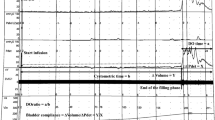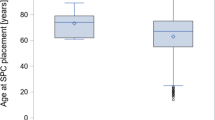Abstract
Study design:
The study was designed as a single-arm clinical trial.
Objectives:
To investigate the therapeutic effects of detrusor botulinum toxin A (BoNT-A) treatment in patients with different levels of spinal cord injury (SCI) and types of detrusor sphincter dyssynergia (DSD).
Setting:
Patients with chronic suprasacral SCI and neurogenic detrusor overactivity (NDO) were treated with 200-U BoNT-A detrusor injection in a tertiary university hospital in Taiwan.
Methods:
Outcome assessment of urodynamic parameters and therapeutic satisfaction were performed at 3 and 6 months among patients with different demographics, SCI levels and types of DSD. The treatment outcomes were assessed by changes in Urogenital Distress Inventory 6-item short form (UDI-6), quality of life (QoL) index and detrusor pressure at maximum flow rate (Pdet.Qmax).
Results:
A total of 38 patients with a mean age of 40.1±12.4 years and median duration of SCI of 10.3 years were enrolled. Satisfactory response was reported in 23 (60%) patients. Significant improvements in the UDI-6 and QoL were reported and significant increases of cystometric bladder capacity and post-void residual were noted in overall patients after treatment. Patients with different clinical demographics and urodynamic parameters had similar treatment outcomes and UDI-6 scores. In 11 patients receiving repeat injections of 300 U of BoNT-A after failure of a previous 200 U injection, the treatment outcomes were not significantly different, except that the PdetQmax at 6 months were higher in the group that received 200 U of BoNT-A.
Conclusion:
Patients with different SCI levels or DSD types had similar treatment outcomes after detrusor 200 U BoNT-A injections for NDO.
Similar content being viewed by others
Log in or create a free account to read this content
Gain free access to this article, as well as selected content from this journal and more on nature.com
or
References
Weld KJ, Graney MJ, Dmochowski RR . Clinical significance of detrusor sphincter dyssynergia type in patients with post-traumatic spinal cord injury. Urology 2000; 56: 565–568.
Bennet N, O'Leary M, Patel AS, Xavier M, Erickson JR, Chancellor MB . Can higher doses of oxybutynin improve efficacy in neurogenic bladder? J Urol 2004; 171: 749–751.
Schurch B, Stohrer M, Kramer G, Schmid DM, Gaul G, Hauri D . Botulinum A toxin for treating detrusor hyperreflexia in spinal cord injured patients: a new alternative to anticholinergic drug? Preliminary results. J Urol 2000; 164: 692–697.
Reitz A, Stohrer M, Kramer G, Del Popolo G, Chartier-Kastler E, Pannek J et al. European experience of 200 cases treated with botulinum-A toxin injections into the detrusor muscle for urinary incontinence due to neurogenic detrusor overactivity. Eur Urol 2004; 45: 510–515.
Karsenty G, Denys P, Amarenco G, Gamé X, Mouracade P, Chartier-Kastler E et al. Botulinum toxin A (Botox) intradetrus or injections in adults with neurogenic detrusor overactivity/neurogenic overactive bladder: a systematic literature review. Eur Urol 2008; 53: 275–287.
Blaivas JG, SinhaHP, Zayed AA, Labib KB . Detrusor-external sphincterdyssynergia: a detailed electromyographic study. J Urol 1981; 125: 545–548.
Uebersax JS, Wyman JF, Shumaker SA, McClish DK, Fantl JA . for the continence program for women research group. Short forms to assess life quality and symptom distress for urinary incontinence in women: The incontinence impact questionnaire and the urogenital distress inventory. Neurourol Urodyn 1995; 14: 131–139.
Cockett A, Aso Y, Denis L, Khoury S, Barry M, Carlton CE et al. Recommendation of the International Consensus Committee concerning: 1 Prostate symptom score and quality of life assessment. In: Cockett ATK, Khoury S, Aso Y, et al, (eds). Proceedings, The 2nd International Consultation on Benign Prostatic Hyperplasia (BPH), Paris, June 27-30, 1993. Scientific Communication International Ltd: Channel Island, Jersey, 1994, 553–555.
Maynard Jr FM, Bracken MB, Creasey G, Ditunno Jr JF, Donovan WH, Ducker TB et al. International standards for neurological and functional Classication of spinal cord injury. American Spinal Injury Association. Spinal Cord 1997; 35: 266–274.
Karsenty G, Reitz A, Lindemann G, Boy S, Schurch B . Persistence of therapeutic effect after repeated injections of botulinum toxin type A to treat incontinence due to neurogenic detrusor overactivity. Urology 2006; 68: 1193–1197.
Kalsi V, Apostolidis A, Popat R, Gonzales G, Fowler CJ, Dasgupta P . Quality of life changes in patients with neurogenic versus idiopathic detrusor overactivity after intradetrusor injections of botulinum neurotoxin type A and correlations with lower urinary tract symptoms and urodynamic changes. Eur Urol 2006; 49: 528–535.
Bagi P, Biering-Sorensen F . Botulinum toxin A for treatment of neurogenic detrusor overactivity and incontinence in patients with spinal cord lesions. Scand J Urol Nephrol 2004; 38: 495–498.
McGuire EJ, Savastano JA . Urodynamics and management of the neuropathic bladder in spinal cord injury patients. J Am Paraplegia Soc 1985; 8: 28–32.
Apostolidis A, Dasgupta P, Fowler CJ . Proposed mechanism for the efficacy of injected botulinum toxin in the treatment of human detrusor overactivity. Eur Urol 2006; 49: 644–650.
Smet PJ, Moore KH, Jonavicius J . Distribution and co-localization of calcitonin gene-related peptide, tachykinins, and vasoactive intestinal peptide in normal and idiopathic unstable human urinary bladder. Lab Invest 1997; 77: 37–49.
Klaphajone J, Kitisomprayoonkul W, Sriplakit S . Botulinum toxin type A injections for treating neurogenic detrusor overactivity combined with low-compliance bladder in patients with spinal cord lesions. Arch Phys Med Rehabil 2005; 86: 2114–2118.
Schurch B, Schmid DM, Karsenty G, Reitz A . Can neurologic examination predict type of detrusor sphincter-dyssynergia in patients with spinal cord injury? Urology 2005; 65: 243–246.
Kuo HC . Therapeutic satisfaction and dissatisfaction in patients with spinal cord lesions and detrusor sphincter dyssynergia who received detrusor botulinum toxin a injection. Urology 2008; 72: 1056–1060.
Kuo HC . Botulinum A toxin urethral injection for the treatment of lower urinary tract dysfunction. J Urol 2003; 170: 1908–1912.
Grosse J, Kramer G, Stohrer M . Success of repeat detrusor injections of botulinum A toxin in patients with severe neurogenic detrusor overactivity and incontinence. Eur Urol 2005; 47: 653–659.
Schurch B, Denys P, Kozma CM, Reese PR, Slaton T, Barron RL . Botulinum toxin A improves the quality of life of patients with neurogenic urinary incontinence. Eur Urol 2007; 52: 850–858.
Author information
Authors and Affiliations
Corresponding author
Ethics declarations
Competing interests
The authors declare no conflict of interest.
Rights and permissions
About this article
Cite this article
Chen, CY., Liao, CH. & Kuo, HC. Therapeutic effects of detrusor botulinum toxin A injection on neurogenic detrusor overactivity in patients with different levels of spinal cord injury and types of detrusor sphincter dyssynergia. Spinal Cord 49, 659–664 (2011). https://doi.org/10.1038/sc.2010.179
Received:
Revised:
Accepted:
Published:
Issue date:
DOI: https://doi.org/10.1038/sc.2010.179
Keywords
This article is cited by
-
Onabotulinum toxin A improves neurogenic detrusor overactivity following spinal cord injury: a systematic review and meta-analysis
Spinal Cord (2024)
-
Management of spinal cord injury patients with neurogenic lower urinary tract dysfunction using minimally invasive and surgical therapies in Taiwan
International Urology and Nephrology (2023)
-
The Management of Urine Storage Dysfunction in the Neurological Patient
SN Comprehensive Clinical Medicine (2019)
-
Contemporary Treatment of Detrusor Sphincter Dyssynergia: a Systematic Review
Current Bladder Dysfunction Reports (2018)
-
Effect of detrusor botulinum toxin a injection on urothelial dysfunction in patients with chronic spinal cord injury: a clinical and immunohistochemistry study before and after treatment
Spinal Cord (2016)



